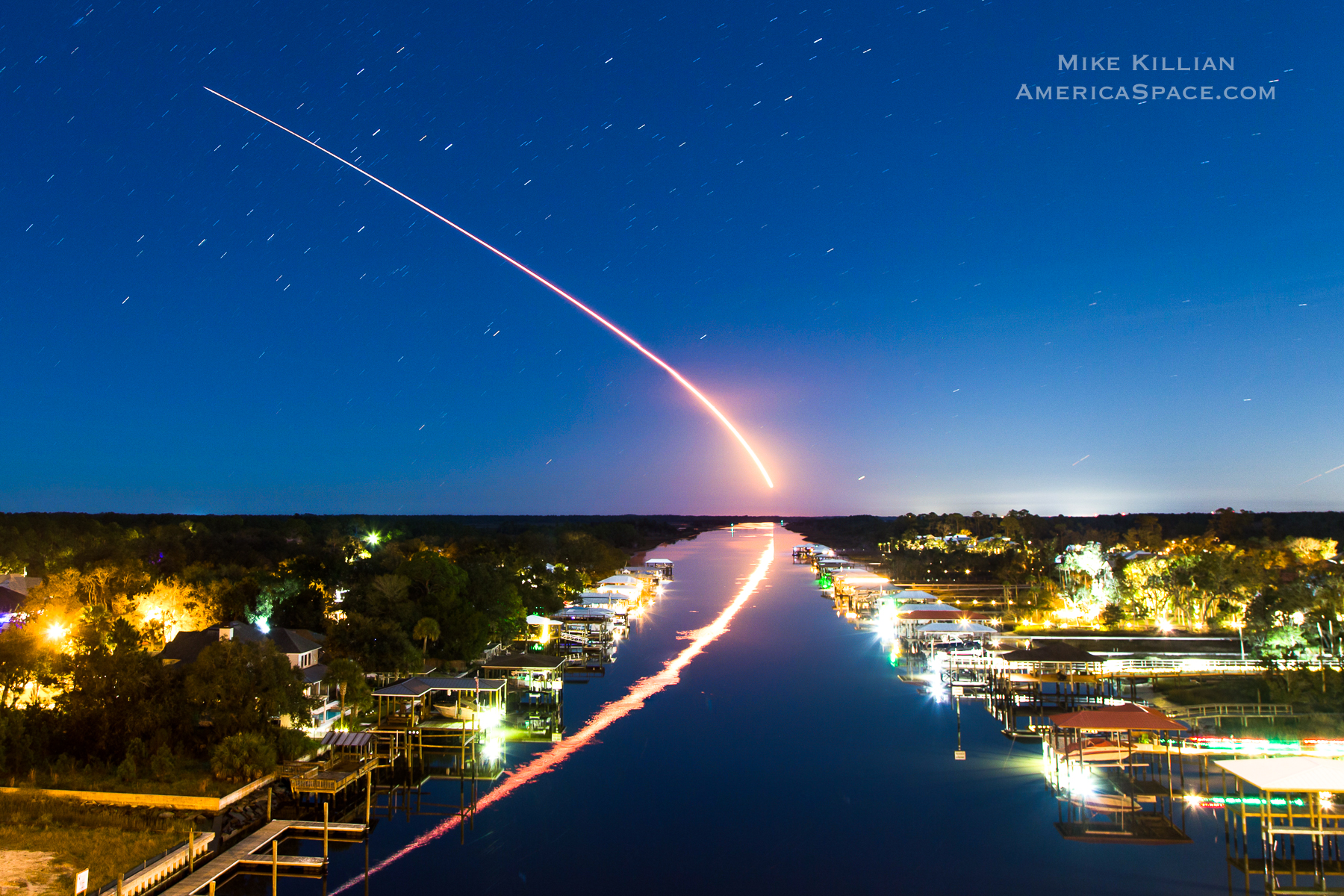
The smoke, noise and euphoria of last Saturday’s spectacular launch of Dragon Endeavour and her crew—NASA veterans Doug Hurley and Bob Behnken—had barely settled when another Falcon 9 booster lifted off from Space Launch Complex (SLC)-40 at Cape Canaveral Air Force Station, Fla., at 9:25 p.m. EDT Wednesday, 3 June. It was SpaceX’s ninth launch in the first 22 weeks of 2020 and secured new “personal bests” for the shortest interval between any two Falcon 9 missions from the East Coast and the first safe return of a booster core from a fifth flight. It also delivered another 60 Starlinks into space, placing the current tally of these low-orbiting internet communications satellites at almost 500.
Although SpaceX has on several occasions flown missions within days of each other—most recently in December 2018, with the launches of the SSO-A SmallSat Express from Vandenberg Air Force Base, Calif., and the CRS-16 Dragon from the Cape, only 48 hours apart—it has never before staged a pair of flights from the East Coast within such close proximity. Only four days passed between the Saturday afternoon ride of Hurley and Behnken and the Wednesday evening ascent of Starlink. The closest before tonight was six days which elapsed between the commercial GovSat-1/SES-16 mission on 31 January 2018 and the maiden voyage of the Falcon Heavy on 6 February 2018.

As outlined previously by AmericaSpace, this particular Starlink mission has been waiting in the wings for several weeks. Originally scheduled to fly on 17 May, it was pushed at least 24 hours to the right following the 16 May postponement of United Launch Alliance’s (ULA) Atlas V mission with the USSF-7 payload for the U.S. Space Force. When the Atlas flew successfully the following day, hope was kindled that SpaceX might launch on the 18th. But it was not to be. The threat of Tropical Storm Arthur, which crept into the Bahamas in the middle of May and was officially declared a tropical storm on the 17th. It intensified in ferocity off the Florida coast over the next few days. In response to the tropical storm and the closeness of the targeted 27 May launch of Demo-2, SpaceX opted to postpone the Starlink mission until the beginning of June.

In keeping with all Falcon 9 missions launched thus far in 2020, with the exception of Demo-2, the Starlink flight would utilize a previously-used booster, in this case “B1049”. Flown on four occasions between September 2018 and last January, it achieved the first U.S. space launch of the 2020s, delivering the heavyweight Telstar 18V communications satellite to geostationary transfer orbit, the final batch of Iridium NEXT satellites and two 60-strong batches of Starlinks. Although its sibling B1048 became the first Falcon 9 core to fly a fifth mission in March 2018, it failed to successfully land on the Autonomous Spaceport Drone Ship (ASDS) at the end of its flight. As such, tonight’s successful landing of B1049 makes it the first Falcon 9 to complete as many as five missions.

Paired with a sparkling-new second stage, B1049 was rolled from the Horizontal Integration Facility (HIF) to SLC-40 for the customary Static Fire Test of its nine Merlin 1D+ first-stage engines on 13 May, ahead of Tropical Storm Arthur. It was returned to the HIF to await the completion of the Demo-2 launch campaign, before being rolled back out to the pad. As is normal for Starlink launches, the payload fairing was pre-integrated with the stack. Weather conditions for Wednesday were predicted to be generally favorable, with a 60-percent likelihood of an acceptable outlook at T-0, tempered by a risk of violating the Cumulus Cloud Rule and the Thick Cloud Layer Rule. The 45th Weather Squadron at Patrick Air Force Base also identified a preferred launch period between 9:55 p.m. and 10:56 p.m. EDT.

Liftoff came a couple hours after sunset, marking SpaceX’s third launch of the year in the hours of darkness. And with its usual blend of perfection, B1049 speared straight and true, the fury of its nine Merlins burning hot and hard for 2.5 minutes until staging. The single Merlin 1D+ Vacuum engine of the second stage then ignited to commence the process of delivering the 60 Starlinks into low-Earth orbit. In the meantime, its job done, B1049 commenced its descent back to a drone ship landing, becoming the first East Coast mission to return to the ASDS “Just Read the Instructions”. This particular drone ship was previously based off the West Coast and supported seven returning Falcon 9 cores from Vandenberg launches between January 2017 and January 2019—the most recent of which was actually another B1049 mission—and was today supporting its first flight out of the Cape.

With the completion of today’s mission, 480 Starlinks are currently in orbit, following launches in May and November 2019, two flights in January and one apiece in February, March, April and tonight. SpaceX founder Elon Musk has previously announced plans to have up to 12,000 of these low-orbiting internet communications satellites aloft by the middle of the decade, although concerns have been expressed by astronomers that their presence and strong optical characteristics may interfere with observations. As such, tonight’s mission included the first use of “VisorSat” optical-darkening technology to limit their visibility in the night sky.

Coming up next in June is another anticipated Starlink launch, together with the flight of the third Block III Global Positioning System (GPS) satellite on 30 June. Previously targeted to fly in late March, GPS III-03 was delayed in part due to the relentless worldwide march of the COVID-19 coronavirus. If both missions fly on time, June 2020 may become the second time this year and only the fifth time in SpaceX history that as many as three Falcon 9s will have flown in a single calendar month.





